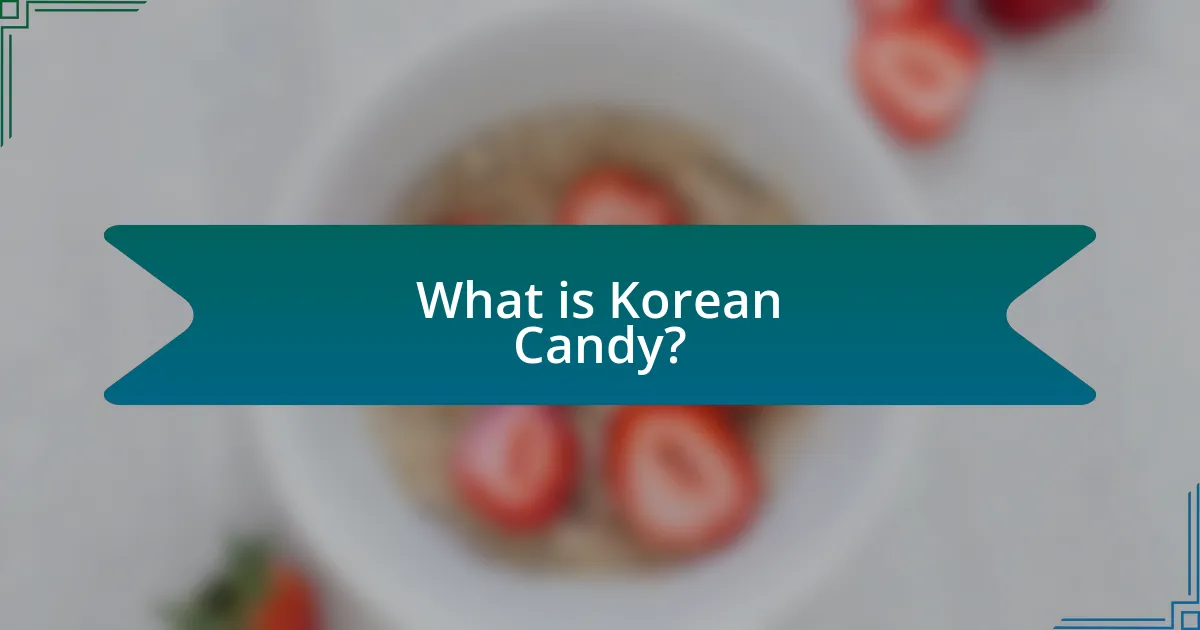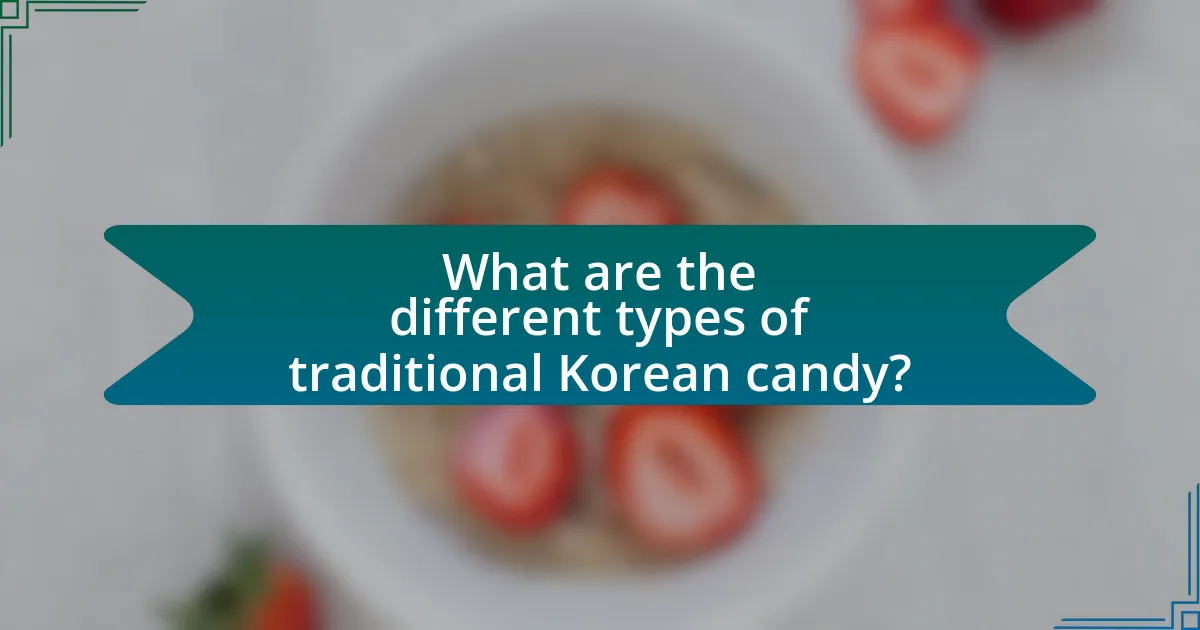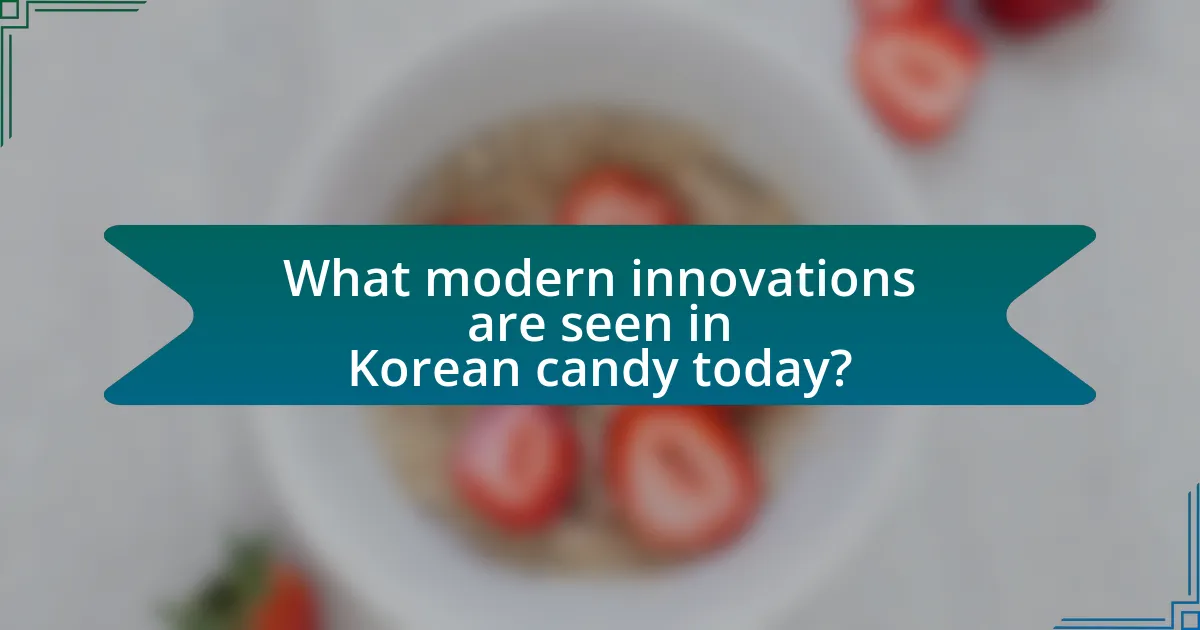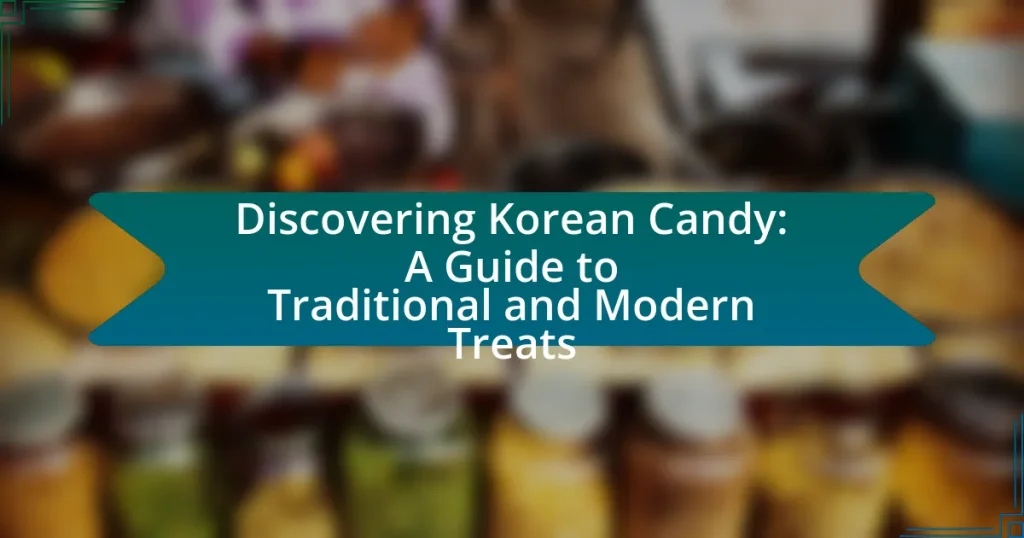Korean candy encompasses a diverse range of sweet confections from South Korea, including both traditional treats like “yakgwa” and “tteok,” as well as modern innovations such as “Pepero” and “Choco Pie.” The article explores the unique ingredients and flavors that distinguish Korean candy from those in other cultures, highlighting the influence of historical events on its development. It also examines the role of traditional methods in shaping taste, the significance of specific candies during cultural celebrations, and the impact of globalization on contemporary offerings. Additionally, the article provides insights into popular brands, marketing strategies, and tips for selecting authentic Korean candies.

What is Korean Candy?
Korean candy refers to a variety of sweet confections that originate from South Korea, encompassing both traditional and modern treats. Traditional Korean candies, such as “yakgwa” (honey cookies) and “sikhye” (sweet rice drink), often incorporate ingredients like rice, honey, and nuts, reflecting the country’s culinary heritage. Modern Korean candies, including popular items like “Pepero” (chocolate-covered biscuit sticks) and “Choco Pie,” have gained international recognition and are characterized by their unique flavors and textures. The diversity of Korean candy showcases the blend of historical influences and contemporary tastes, making it a significant aspect of Korean culture and cuisine.
How is Korean candy different from candies in other cultures?
Korean candy differs from candies in other cultures primarily in its unique flavors and ingredients, often incorporating traditional elements like rice, sweet potato, and red bean. For example, traditional Korean candies such as “tteok” (rice cakes) and “yakgwa” (honey cookies) emphasize chewy textures and natural sweetness, contrasting with the more sugar-centric and chocolate-based candies prevalent in Western cultures. Additionally, Korean candies often feature flavors like matcha, sesame, and fruit, which are less common in Western sweets. This distinct approach reflects Korea’s culinary heritage and cultural preferences, making Korean candy a unique experience compared to candies from other regions.
What unique ingredients are commonly used in Korean candy?
Unique ingredients commonly used in Korean candy include rice flour, sweet red bean paste, and various fruits like yuzu and persimmon. Rice flour serves as a base for many traditional candies, providing a chewy texture, while sweet red bean paste is often used as a filling or flavoring, reflecting the traditional Korean palate. Fruits such as yuzu and persimmon are incorporated for their distinct flavors, enhancing the overall taste profile of the candies. These ingredients are integral to both traditional and modern Korean confections, showcasing the country’s culinary heritage.
How do traditional methods influence the taste of Korean candy?
Traditional methods significantly influence the taste of Korean candy by utilizing natural ingredients and time-honored techniques that enhance flavor and texture. For instance, the process of making rice cakes, or “tteok,” involves steaming glutinous rice and often incorporates ingredients like red bean paste or sesame, which contribute to a rich, authentic taste. Additionally, traditional methods such as hand-pulling and kneading during the preparation of candies like “yakgwa” (honey cookies) allow for a unique texture and depth of flavor that modern methods may not replicate. Historical practices, such as fermenting ingredients for extended periods, also add complexity to the taste profile of these confections, making them distinctively Korean.
What are the historical origins of Korean candy?
The historical origins of Korean candy can be traced back to ancient times, particularly during the Three Kingdoms period (57 BC – 668 AD), when sugar was introduced to Korea from China. Initially, Korean sweets were made from natural ingredients like honey, fruits, and grains. Over time, the introduction of refined sugar in the late 19th century led to the development of more diverse and complex candy varieties. Traditional candies such as “yakgwa” (honey cookies) and “tteok” (rice cakes) reflect the evolution of Korean confectionery, showcasing the integration of local ingredients and cultural practices. The historical context of these candies illustrates their significance in Korean culture, often associated with celebrations and rituals.
How did historical events shape the development of Korean candy?
Historical events significantly influenced the development of Korean candy, particularly through cultural exchanges and economic changes. The introduction of sugar during the late Joseon Dynasty, following trade with Western countries, led to the creation of new confections that incorporated this ingredient, transforming traditional rice-based sweets. Additionally, the Japanese occupation from 1910 to 1945 introduced new manufacturing techniques and ingredients, which further diversified the types of candy available in Korea. The post-war economic growth in the 1960s and 1970s also spurred the commercialization of candy, leading to the emergence of mass-produced varieties that catered to changing consumer tastes. These historical contexts illustrate how external influences and internal developments shaped the evolution of Korean candy.
What traditional candies have stood the test of time in Korea?
Traditional candies that have stood the test of time in Korea include Tteok, which are rice cakes often filled with sweetened red bean paste, and Yeot, a type of traditional Korean taffy made from grains and sweeteners like honey or malt. Tteok has been consumed for centuries, often during celebrations and holidays, while Yeot has historical significance as a nutritious snack, dating back to the Goryeo Dynasty. Both candies reflect Korea’s rich culinary heritage and continue to be enjoyed by generations.

What are the different types of traditional Korean candy?
Traditional Korean candy includes types such as tteok, yeot, and gangjeong. Tteok refers to rice cakes that can be sweetened and flavored with ingredients like red bean or sesame. Yeot is a type of traditional Korean confection made from glutinous rice or barley, often sweetened with honey or malt syrup. Gangjeong consists of puffed rice or glutinous rice that is coated with syrup and often mixed with nuts or seeds. These candies have historical significance and are often enjoyed during celebrations and festivals in Korea.
What are some popular examples of traditional Korean sweets?
Some popular examples of traditional Korean sweets include Tteok, which are rice cakes made from glutinous rice and often filled with sweetened red bean paste, and Hangwa, a type of confectionery made from honey, grains, and nuts. Additionally, Yaksik, a sweet rice dish flavored with honey and nuts, and Bungeoppang, fish-shaped pastries filled with sweet red bean paste, are also well-known. These sweets have deep cultural significance and are often enjoyed during festivals and celebrations in Korea.
How is Tteok (rice cake) made and enjoyed in Korea?
Tteok, or rice cake, is made in Korea by steaming glutinous rice flour, which is then shaped into various forms and often filled with ingredients like red bean paste or fruits. The preparation involves soaking the rice, grinding it into a fine powder, and then mixing it with water to create a dough that is steamed until it becomes chewy and firm. Tteok is enjoyed during celebrations, festivals, and special occasions, often served with tea or as part of traditional meals, highlighting its cultural significance in Korean cuisine.
What role does Hangwa (traditional sweets) play in Korean culture?
Hangwa plays a significant role in Korean culture as a traditional sweet that symbolizes celebration and hospitality. These sweets are often prepared for important occasions such as holidays, weddings, and birthdays, reflecting the cultural emphasis on sharing and community. Historically, Hangwa has been made using natural ingredients like rice, honey, and fruits, which not only showcases the agricultural heritage of Korea but also emphasizes the importance of health and well-being in Korean culinary practices. The intricate designs and vibrant colors of Hangwa also serve as a visual representation of Korean artistry and craftsmanship, making them not just food but also a form of cultural expression.
How are traditional Korean candies typically served or consumed?
Traditional Korean candies are typically served in small, bite-sized pieces, often arranged on decorative plates or in colorful wrappers. These candies are commonly consumed during celebrations, holidays, and family gatherings, where they are offered as a gesture of hospitality. For example, rice cakes like “tteok” are often enjoyed during special occasions such as birthdays and weddings, highlighting their cultural significance. Additionally, traditional candies may be paired with tea, enhancing the overall tasting experience.
What occasions call for specific types of Korean candy?
Certain occasions in Korean culture call for specific types of Korean candy. For example, during Chuseok, the harvest festival, families traditionally prepare and share songpyeon, a rice cake filled with sweetened sesame or red bean paste, symbolizing gratitude for the harvest. Similarly, during birthdays, it is customary to serve baekseolgi, a steamed white cake, which represents purity and good fortune. Additionally, at weddings, guests often receive traditional candies like yaksik, a sweet rice dish, symbolizing prosperity and happiness. These candies are integral to the celebrations, reflecting cultural values and traditions associated with each occasion.
How do presentation styles vary among different types of Korean candy?
Presentation styles among different types of Korean candy vary significantly, reflecting cultural traditions and modern influences. Traditional candies like taffy (yeot) are often presented in simple, rustic packaging, emphasizing natural ingredients and artisanal craftsmanship, while modern candies, such as chocolate-covered snacks, utilize vibrant, eye-catching packaging that appeals to contemporary aesthetics. For example, traditional rice cakes (tteok) are typically displayed on decorative plates during celebrations, showcasing their intricate designs, whereas mass-produced candies are often found in colorful wrappers designed for convenience and shelf appeal. This contrast highlights the blend of heritage and innovation in Korean confectionery.

What modern innovations are seen in Korean candy today?
Modern innovations in Korean candy today include the use of unique flavors, health-conscious ingredients, and advanced packaging technologies. Korean candy manufacturers are increasingly incorporating ingredients like sweet potato, matcha, and various fruits to create distinctive taste profiles that appeal to diverse consumer preferences. Additionally, there is a growing trend towards using natural sweeteners and reducing artificial additives, reflecting a shift towards healthier options. Advanced packaging technologies, such as resealable pouches and eco-friendly materials, enhance convenience and sustainability, making these candies more appealing to modern consumers.
How has globalization influenced the evolution of Korean candy?
Globalization has significantly influenced the evolution of Korean candy by introducing diverse flavors and production techniques from around the world. This integration has led to the fusion of traditional Korean ingredients, such as rice and red bean, with international elements like chocolate and fruit flavors, resulting in innovative products that appeal to a broader audience. For instance, the rise of global snack culture has prompted Korean manufacturers to adapt their offerings, leading to the creation of candies like Choco Pie, which combines Western-style chocolate coating with a traditional cake base. Additionally, the accessibility of international markets has allowed Korean candy brands to expand their reach, increasing the popularity of these products both domestically and internationally.
What new flavors and ingredients are being introduced in modern Korean candy?
Modern Korean candy is introducing innovative flavors and ingredients such as matcha, sweet potato, and various fruit infusions like yuzu and mango. These flavors reflect a blend of traditional tastes with contemporary culinary trends, appealing to both local and international markets. For instance, the incorporation of matcha aligns with the global popularity of green tea, while sweet potato offers a unique twist that resonates with Korean cuisine. Additionally, the use of yuzu, a citrus fruit, showcases a growing interest in exotic flavors, enhancing the diversity of candy offerings in Korea.
How do contemporary brands market their Korean candy products?
Contemporary brands market their Korean candy products through a combination of social media engagement, influencer partnerships, and targeted advertising. Brands utilize platforms like Instagram and TikTok to showcase visually appealing content that highlights the unique flavors and packaging of their candies, appealing to younger demographics. For instance, brands often collaborate with popular influencers who create unboxing videos or taste tests, which can significantly increase visibility and consumer interest. Additionally, targeted online ads leverage data analytics to reach specific consumer segments interested in Asian snacks, enhancing the effectiveness of their marketing strategies. This multi-faceted approach has proven successful, as evidenced by the growing popularity of Korean candy in international markets, with sales increasing by over 20% annually in regions like North America and Europe.
What are some popular modern Korean candy brands?
Some popular modern Korean candy brands include Lotte, Haitai, and Orion. Lotte is known for its wide range of confectionery products, including Choco Pie, which has gained international popularity. Haitai produces various snacks and candies, such as the popular “Pepero,” a chocolate-covered biscuit stick. Orion is recognized for its “Choco Pie” as well, along with other sweets like “Oreo” and “Scone.” These brands have established a strong presence in both domestic and international markets, contributing to the global appeal of Korean sweets.
What unique offerings do these brands provide compared to traditional options?
These brands provide innovative flavors and textures that differentiate them from traditional options. For instance, modern Korean candy brands often incorporate unique ingredients like sweet potato, matcha, or even spicy elements, which are not typically found in conventional candies. Additionally, they utilize contemporary packaging designs and marketing strategies that appeal to younger consumers, enhancing the overall experience. This shift towards fusion flavors and aesthetic presentation reflects a broader trend in the food industry, where consumer preferences are evolving towards more adventurous and visually appealing products.
How do these brands incorporate cultural elements into their products?
Brands incorporate cultural elements into their products by utilizing traditional ingredients, flavors, and packaging designs that reflect Korean heritage. For example, many Korean candy brands use ingredients like rice, red bean, and sweet potato, which are staples in Korean cuisine, to create authentic flavors. Additionally, packaging often features traditional Korean motifs and colors, enhancing the cultural connection. This approach not only appeals to local consumers but also attracts international markets interested in authentic cultural experiences, as evidenced by the growing popularity of Korean snacks globally, which has increased by over 30% in recent years according to market research.
What tips can help you choose the best Korean candy to try?
To choose the best Korean candy, consider flavor preferences, texture, and ingredient quality. Korean candies offer a variety of flavors, including sweet, sour, and savory, so identifying your preferred taste can guide your selection. Additionally, textures range from chewy to crunchy, which can enhance your enjoyment. Look for candies made with high-quality ingredients, as this often indicates better taste and authenticity. Popular options like Pepero and Choco Pie are widely appreciated for their flavor and texture, making them good starting points.
How can you identify authentic Korean candy when shopping?
To identify authentic Korean candy when shopping, look for products that have Korean labeling, including Hangul characters, which indicate the origin and authenticity of the candy. Authentic Korean candies often feature well-known brands such as Lotte or Haitai, and they may include traditional ingredients like rice flour, red bean, or sweet potato. Additionally, check for certifications or seals that indicate the product is made in Korea, as these can serve as proof of authenticity.
What are some recommended combinations of traditional and modern candies to experience?
Recommended combinations of traditional and modern Korean candies include pairing traditional rice cakes (tteok) with modern chocolate-covered snacks like Pepero. Another combination is enjoying honeyed traditional candies such as yakgwa alongside contemporary gummy candies like Chupa Chups. These pairings highlight the contrast between the chewy textures of traditional sweets and the varied flavors of modern confections, providing a comprehensive tasting experience that showcases the evolution of Korean candy culture.


